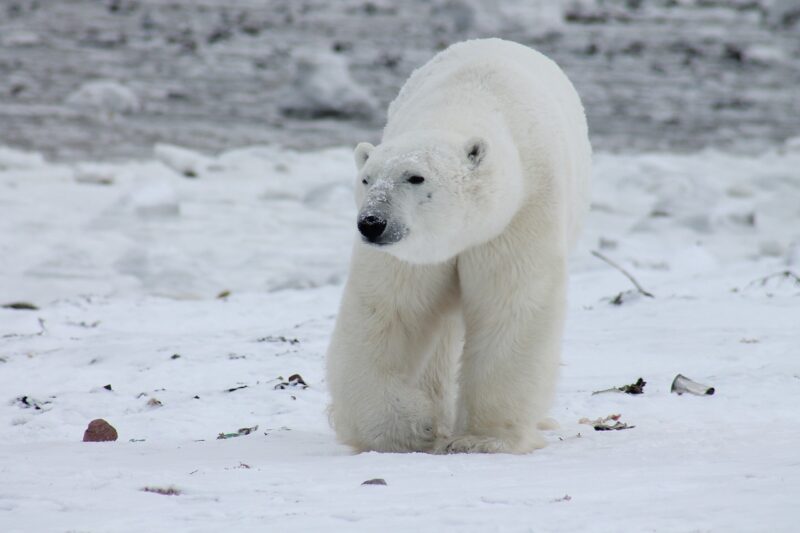Most people would describe polar bears as arctic bears that have white fur, unlike their brown-furred cousins from warmer climates. Most people, though, would be wrong. Polar bears’ iconic white fur isn’t actually white. In fact, polar bears don’t even always look white. They come in a surprising range of colors. However, their fur isn’t really any of these colors, either. The truth about polar bear fur is actually really weird. Polar bear fur is fundamentally different from the fur of brown bears or black bears.

Polar Bear Basics
Polar bears are white bears that are both marine mammals and the largest land predators in the world. Adult polar bears stand 11 feet tall when reared up on their hind legs, or at least the male polar bears do. They spend a lot of time on the sea ice and swimming in the frigid arctic waters hunting for the seals that are their primary food source. They even have webbed feet so they can swim faster. Unlike all other bear species, they don’t retreat to their dens for the winter because their primary food source is available year-round. Instead, they have two layers of fur and a thick layer of fat to keep body heat in and body temperature high. (However, female bears with young cubs will den during the winter because the cubs are too young to survive the extreme cold.)
Polar bears only live in the Arctic. The only part of the United States they are found in is Alaska. A town called Churchill, Canada, is the polar bear capital of the world, with the highest concentration of the creatures anywhere. Indeed, they gather there in the fall, waiting for the bay to freeze so they can begin their winter seal hunts.
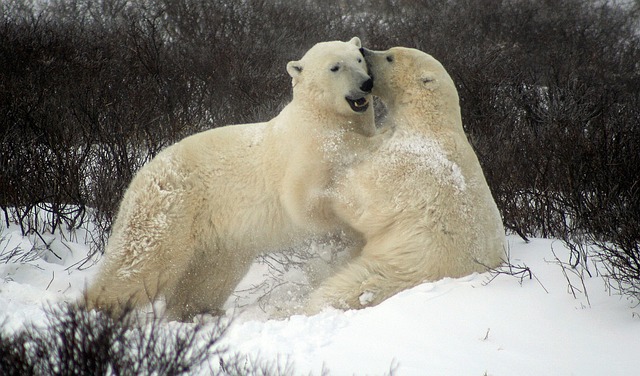
Polar Bear Fur
Polar bears actually have two layers of hair. The one closest to the skin is called the undercoat, and it’s very short. There is also an outer layer of coarse guard hairs, which are long enough to completely cover the undercoat. Both of these layers are completely colorless. Polar bear hairs have no pigment at all. So it might seem that polar bears look white because they have white skin that shows through their transparent, colorless hair.
However, that’s not how it works. Polar bears don’t have white skin or even pink skin. Polar bears’ skin is actually black, which you can see on their black noses. And just because a polar bear’s fur is colorless does not mean that you can see through it.
Polar bear fur has a white appearance because of the way the hollow hairs scatter the sunlight. You see, when light hits the surface of a transparent material, some of it reflects off the surface, and some just goes through it. Like with glass. Well, thanks to the hollow cores of the translucent hairs, each hair has multiple transparent surfaces for light to hit.
Some of the light from the sun’s rays enters the hair, and some are reflected off of it. And some are reflected off the inner surfaces, including the surfaces of the hollow core. So a lot of the light that hits the polar bear’s fur gets bounced around inside the hair follicles like in a fiber optic cable. So when it finally bounces back out of the hair, it’s been scattered around a lot. Basically, it shakes up all the different colors in the light until it looks pure white. So the polar bear’s fur looks like it’s white, despite being semi-transparent fur laid over black skin.
The other cause of the apparent white color comes from that black skin, oddly enough. That light scattering effect only works on visible light, but sunlight also has other kinds of light that you can’t see, including ultraviolet light. Some of that UV light makes it to the bear’s skin and gets absorbed by it. Because of the fluorescence effect, some of the energy of that UV light is released as visible white light.
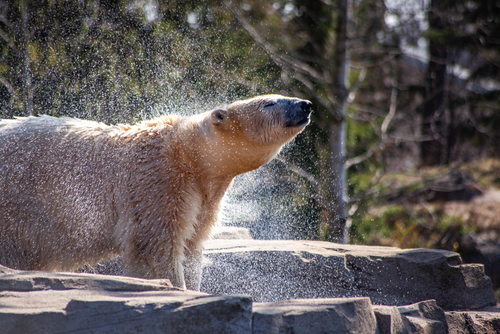
Red, Orange, and Gray Polar Bears
Because a polar bear’s fur gets its color from light scattering particles instead of pigment, it actually changes color when the light does. If you look at a polar bear in the early morning or the late evening, around sunrise or sunset, that bear will often look red, orange, or even a mix of these colors. That’s simply the result of the red and orange light of sunrise or sunset hitting the bear’s fur.
The sunrise/sunset effect can also make polar bears look gray. So can a cloudy day. When the light levels are low, not so much light gets scattered off the hollow guard hairs, letting the darker skin underneath start to show through a little. The result is a gray polar bear. Which will look white again under direct sunlight.
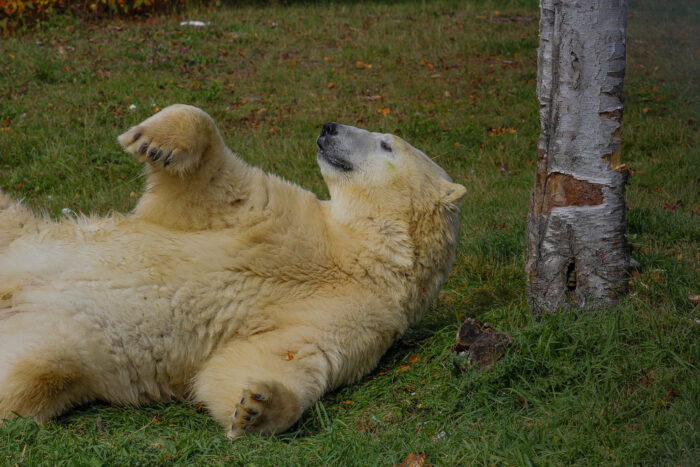
Yellow Polar Bears
Some polar bears are yellow. Actually yellow. This one isn’t a weird light-scattering effect, it’s the result of eating too many seals. An overabundance of seal oil in the diet can dye a polar bear’s fur yellow.
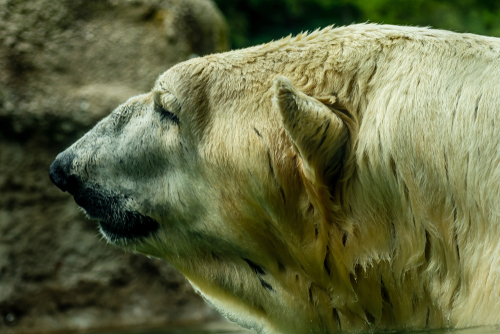
Green Polar Bears
Some polar bears even have green fur. Specifically, captive polar bears sometimes turn green. You see, polar bears love scratching themselves. In zoos, their enclosures usually have plenty of concrete surfaces to scratch themselves on. Concrete leaves deep scratches and holes in polar bear fur. And, because zoos are generally a lot warmer than the arctic region regions that are their natural habitat, their swimming pools (all polar bears need plenty of open water for swimming space) tend to have algae growth problems. And, when the bears swim through the algae, they get that algae all over their fur, and the algae then gets into the hairs through the tiny holes and scratches left by the concrete. It sometimes thrives there, turning their fur a bright green color.
Polar Bears and the Future
Unfortunately, the polar bear population is in decline. The change in climate has been reducing the size of polar bears’ habitats. As a result, fewer polar bear cubs are born every year. The future of this incredible species is very much in doubt. Conservation efforts are underway.
Recent Posts
The only venomous snakes in Washington State are Northern Pacific Rattlesnakes. The Northern Pacific Rattlesnake (Crotalus oreganus oreganus) is a sub-species of the Western Rattlesnake. Anyone...
Skunks are not classified as true hibernators. But they go into a state of torpor when the weather gets cold. Skunks are light sleep hibernators, along with opossums, bears, and raccoons. ...

